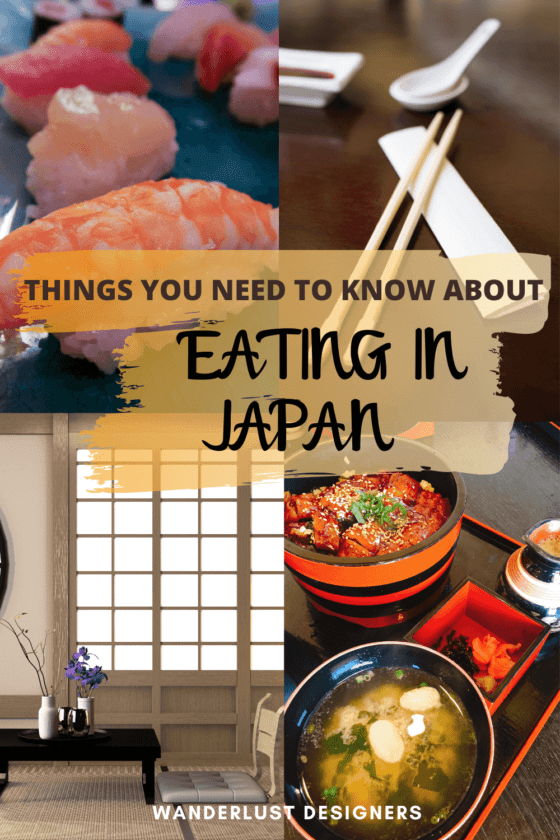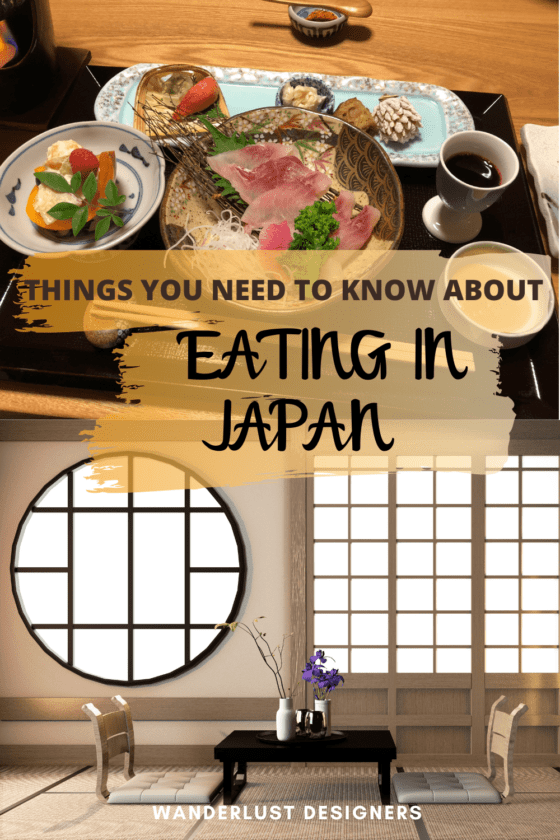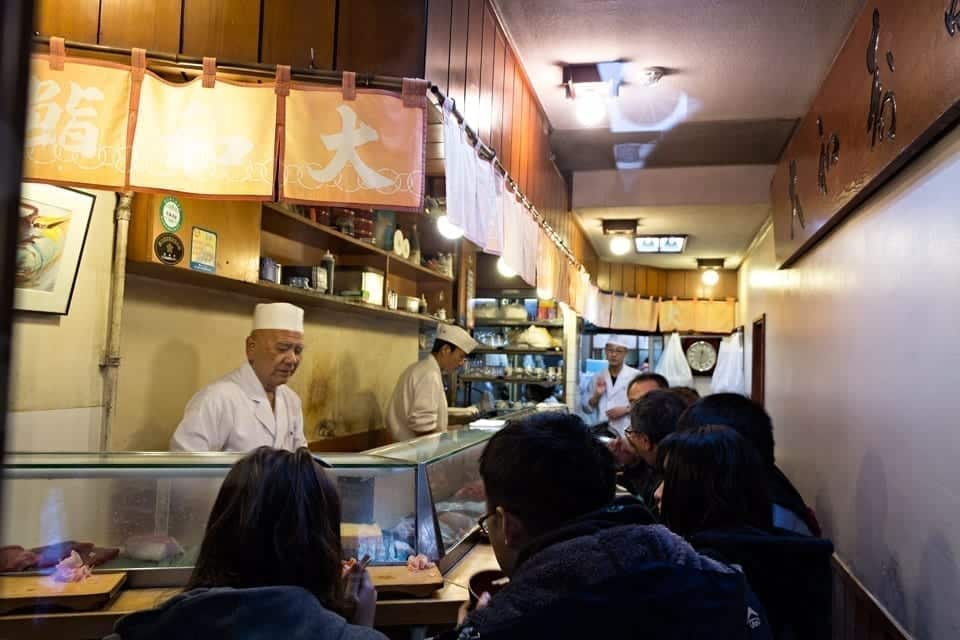The Japanese Food Culture: Introduction to Eating in Japan
Just like everything else, eating in Japan comes with its very own rules and customs.
If you break some of these rules, the Japanese might wince and just roll their eyes at the typical tourist, but some could be called food taboos and breaking them would be deeply offensive.
So, it is a good idea to prepare a bit and learn more about Japanese food culture.
With a little bit of knowledge and preparation, you’re virtually guaranteed to turn your trip to Japan into an unforgettable gastronomical experience. That’s why we have this handy guide to Japanese food culture ready for you.
17 Things to know about Japanese Food Culture
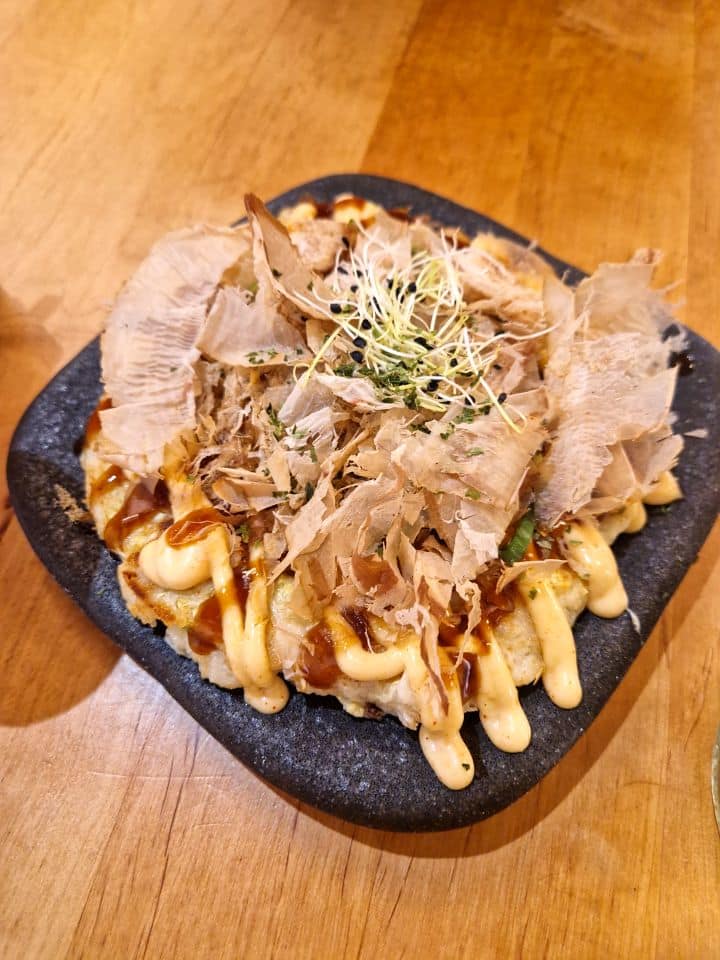
#1 Many restaurants specialize in only one type of food
Be it sushi, okonomiyaki (savoury Japanese pancake-omelette-pizza-thing), tempura (deep-fried seafood, vegetables, mushrooms, or meat) – the list goes on, and you should definitely check our article about Food in Japan.
There are some general restaurants as well that serve many types of food, with the most popular being izakaya, which are like pubs.
You can learn more about different types of Japanese restaurants here.
#2 Vegetarians might have some problems
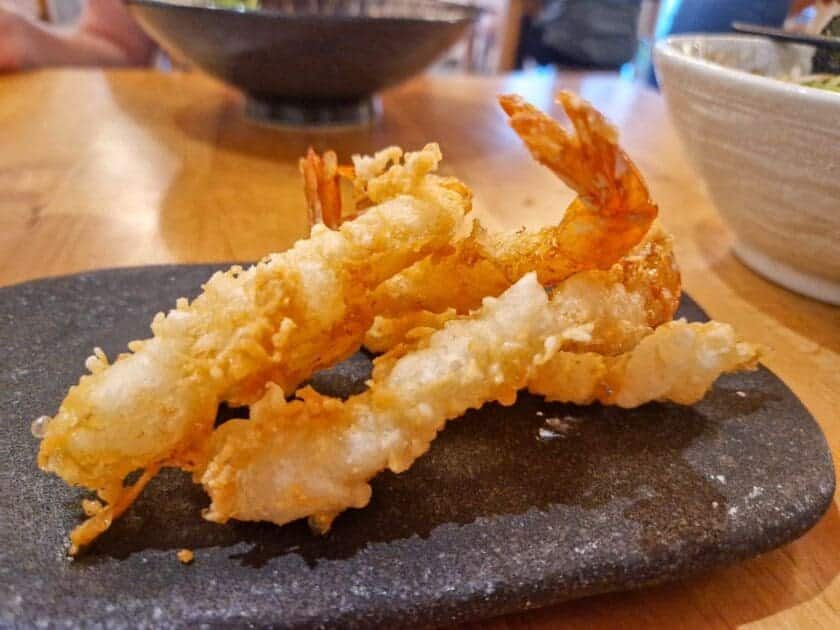
Eating vegetarian in Japan is rather tricky, and let’s not even talk about eating vegan. Although becoming more popular, the understanding of vegetarianism is rather loose in Japanese food culture.
For example, if you ask for vegetarian substitutes for food in a restaurant, you might get offered fish or seafood.
Asking for substitutes when eating in Japan is rather taboo – it’s better to choose a meal that you can eat or ask the waiter to recommend something that you can eat, so you don’t break Japanese dining etiquette.
Most meals in Japan rely heavily on meat products but going meat-free is rather feasible.
Fish though? Much harder to avoid, as even stock for miso soup or a dipping sauce called tentsuyu is made of dashi, which is a stock made from dried fish, and there are dried fish flakes (bonito flakes) put on many meals.
#3 Some restaurants allow smoking, but they should have a sign on the door stating it
In April 2020, a new smoking ban was introduced in Japan, that prohibits indoor smoking. There are some exceptions, one of which is small restaurants that were opened before the law came into effect. But these restaurants should display a sign stating that smoking is allowed inside.
#4 You might not be let into the restaurant even if there are free tables
There is a deep-rooted need in Japan to deliver the best service possible to their customers. Most restaurants will go out of their way to ensure that the diners have the ultimate experience.
That’s why due to the fear of miscommunication and misunderstandings a non-Japanese speaker might be turned away – it might seem rude, but in all honesty, it’s just extreme perfectionism in Japanese food culture.
#5 The price range is huge
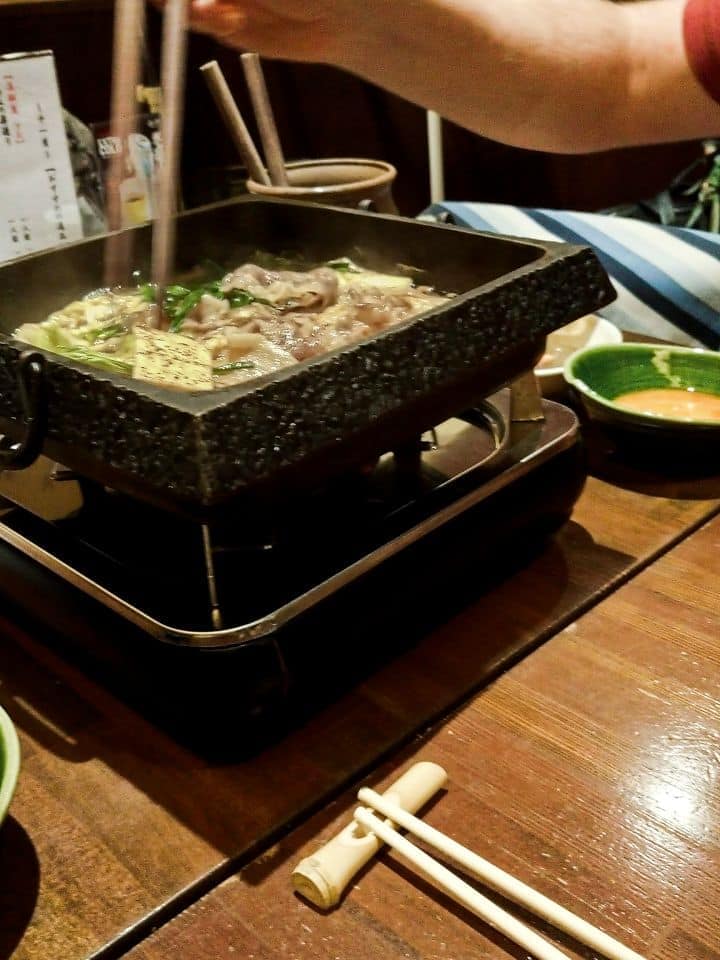
You can have a tasty bento lunch box from a convenience store (don’t forget that you shouldn’t eat it in public places!) or ramen from a vending machine for 6 EUR (7 USD) or an excellent Kobe beef steak for more than a hundred dollars, and everything in between.
The great news is that most of the meals are much closer to the cheaper end. While the food in Japan is generally more expensive than elsewhere in Asia, it is in fact cheaper than in USA or Western Europe.
Plus, many places, including some Michelin restaurants, offer excellent value lunch menus. Some of them, in Tokyo, are as cheap as 10EUR (11USD)!
#6 Every single place uses quality ingredients
Doesn’t matter if you have your lunch from a Michelin-starred restaurant or fast food from a yatai – a street food stall, the Japanese still pride themselves on the quality of the food.
Only the finest ingredients will be used to prepare it, which perfectly represents Japanese food culture.
#7 Don’t expect the menu to be in English
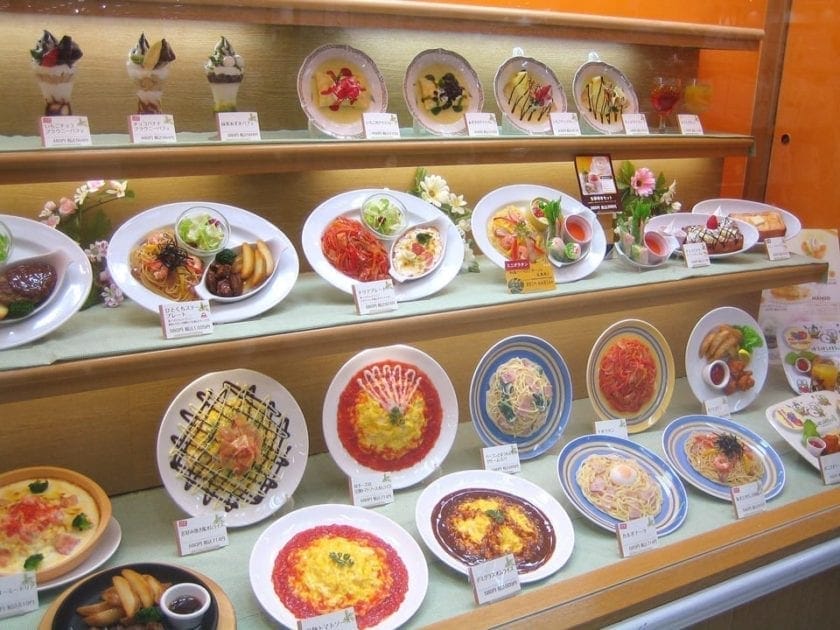
Not many of the restaurants offer English menus, but many have pictures on the menu or plastic or wax models of the meals they offer in the restaurant window. That makes ordering your food relatively easy.
Some restaurants, though, have only Japanese text menus or have the offers written on the wall – again, in Japanese.
If you don’t understand the menu, you can try Google Translate’s Camera translation option.
Or, if you’re feeling adventurous (and your budget allows for some splurging), you can try asking for the server’s recommendations (osusume) or the chef’s choice (omakase).
#8 Some places have vending machines for ordering
Some less expensive (generally ramen joints) have vending machines for ordering your food.
You press the button for the meal you want, pay, get a ticket that you show the staff, sit down and you’ll get your meal soon.
Mostly the buttons would be in Japanese only, but don’t worry, as the Japanese are keen to help.
Do you know what you’d like? Do you have a picture of it? This is where a bit of knowledge, preparation and googling in advance helps.
#9 Don’t walk around while eating in Japan
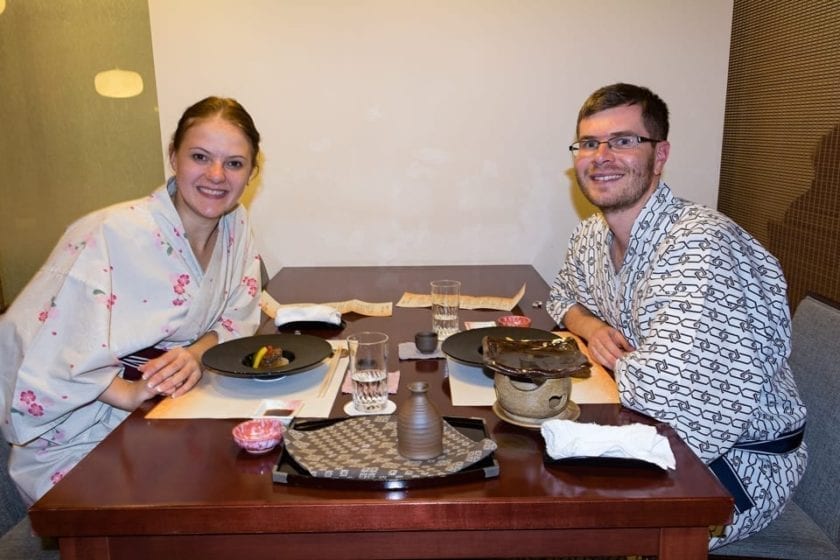
Since you probably have very limited time in Japan, you might consider just grabbing some food in a convenience store and eating it on the way.
Don’t do it! It’s one of the biggest breakings of Japanese dining etiquette!
Generally eating and drinking in public, including public transport, is heavily frowned upon, but it’s especially true in shrines and temples.
Exceptions are quiet benches, near vending machines, or parks.
Most stores that sell food have tables for consuming the food that you have purchased.
#10 You might have to take your shoes off
If you’re visiting a traditional Japanese restaurant or pub which uses tatami floors, chances are, you’ll have to take your shoes off. It will be either before entering the building or right after.
You’ll be asked to store the shoes in a locker (staff might do it for you) or shelves – don’t worry about them being stolen, as Japan is one of the safest countries in the world.
It is done so that outside germs stay where they’re supposed to, that is, outside, and so that the tatami mats are not damaged.
#11 You might have to sit on the floor
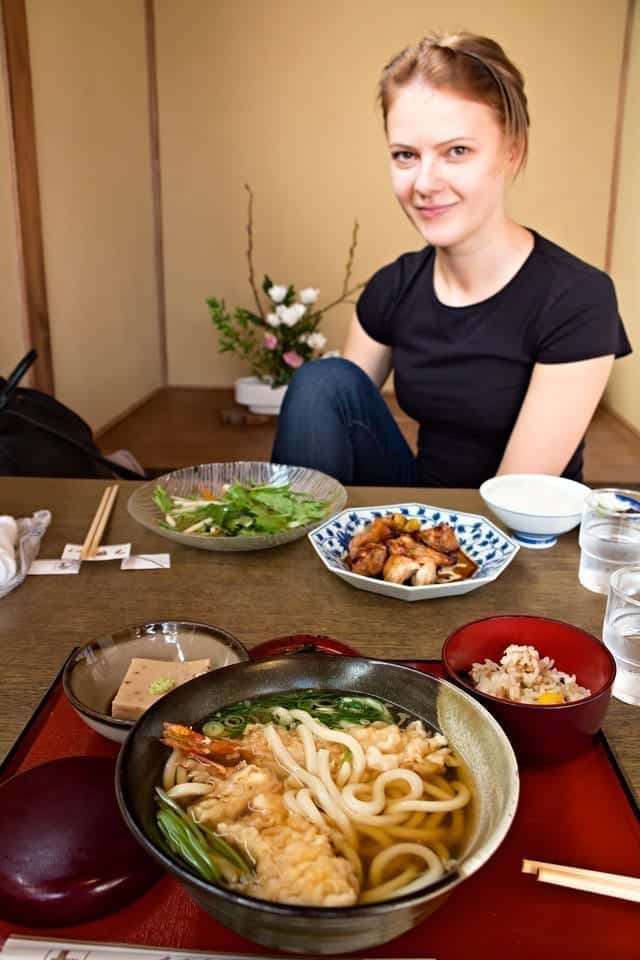
Well, on the floor or on a pillow. Traditionally eating in Japan is done at a small and low table. Although now many of the establishments offer a Western style of dining, that is, a normal table and chairs, in addition to the traditional Japanese zashiki style seating on the tatami floor.
#12 Wet towel (oshibori) before the meal is free
In most restaurants in Japan at the start of your meal, you will receive a wet towel – cool in summer and warm in winter. This towel is free of charge so you can clean your hands before eating.
It is called oshibori, and it’s for cleaning your hands.
Do not clean your face or neck with it! Hands only. In hot summer months using oshibori to clean your mouth will be accepted.
After use, fold the towel and put it back on the dish it came on. During the meal, if a need arises, you can clean your fingers with the towel.
#13 Say the Japanese itadakimasu before eating
Literally, it means “I humbly receive”, but it has a bit of deeper meaning as well.
By using itadakimasu you are honouring everyone who made your meal happen – from the plants who grew for your food, to the fishermen who caught the seafood, to the cooks and servers who prepared and brought you the food.
You should never say itadakimasu while holding your chopsticks!
#14 Don’t just dig in the food
In Japanese food culture, it’s a common courtesy to wait for everyone to receive their food before starting the meal. And the main person of the group, be it your boss or the older member of the group, is the first one to start the meal.
In some places, everyone might not receive food at the same time. In this case, if it’s possible, you should wait for everyone to receive their meals and only then start so you won’t break Japanese dining etiquette then.
Alternatively, you can use the phrase “osaki ni dōzo” (please go ahead) or “osaki ni itadakimasu” (allow me to start before you) so that the meal can be started separately.
Or – there might be otoshi provided, which will avoid the problem of waiting for others!
#15 Otoshi are not free

Drinking and eating in Japan are usually done together, but often the meal that you ordered will arrive sometime after the drinks.
How to solve the problem? Otoshi!
Those are little snacks that you get with your drinks in an izakaya – the traditional Japanese pub-style restaurant.
These snacks are not for free, though, as you might expect. The price of them ranges anywhere from 3 to 6 USD.
#16 You might get water or green tea for free when eating in Japan
After being seated, you might get a glass of water or tea. Don’t worry, unlike otoshi, this is free.
If you’re not served free water or tea is usually available for self-service somewhere in the restaurant.
#17 Almost always chopsticks are used for eating in Japan
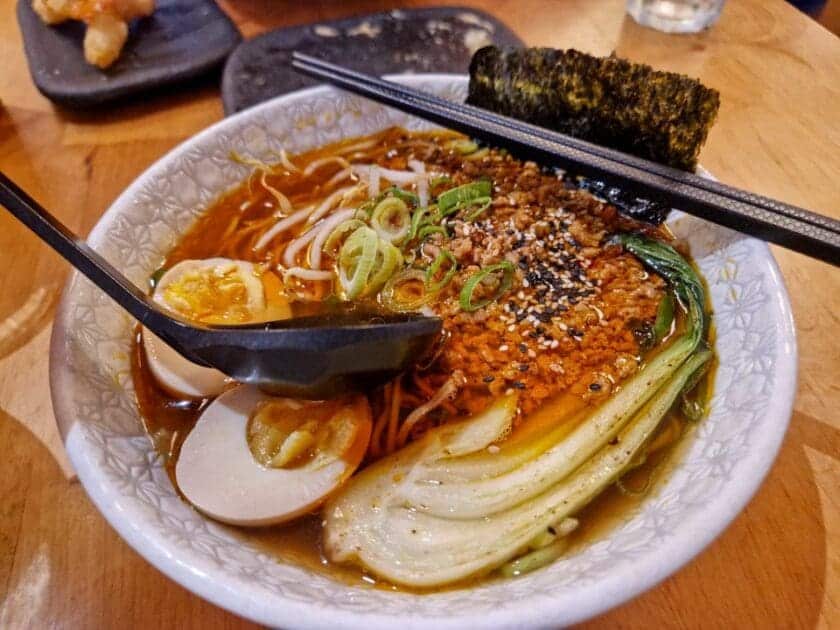
As in many other Asian countries, the main utensil used for eating is chopsticks. Yes, even rice and soup are eaten with them. So, if possible, it makes sense that you train using chopsticks at home before going to Japan. It could be useful to read our guide about chopstick etiquette in Japan.
If you have soup, lift the bowl to your mouth to drink the liquid and use chopsticks to fish out the bigger pieces. For ramen, use the chopsticks to lead the noodles into your mouth. There might be a spoon provided – in that case, use it to drink the liquid.
For some meals such as curries usually large spoons are provided instead of chopsticks.
Tips for eating in Japan: Following Japanese dining etiquette
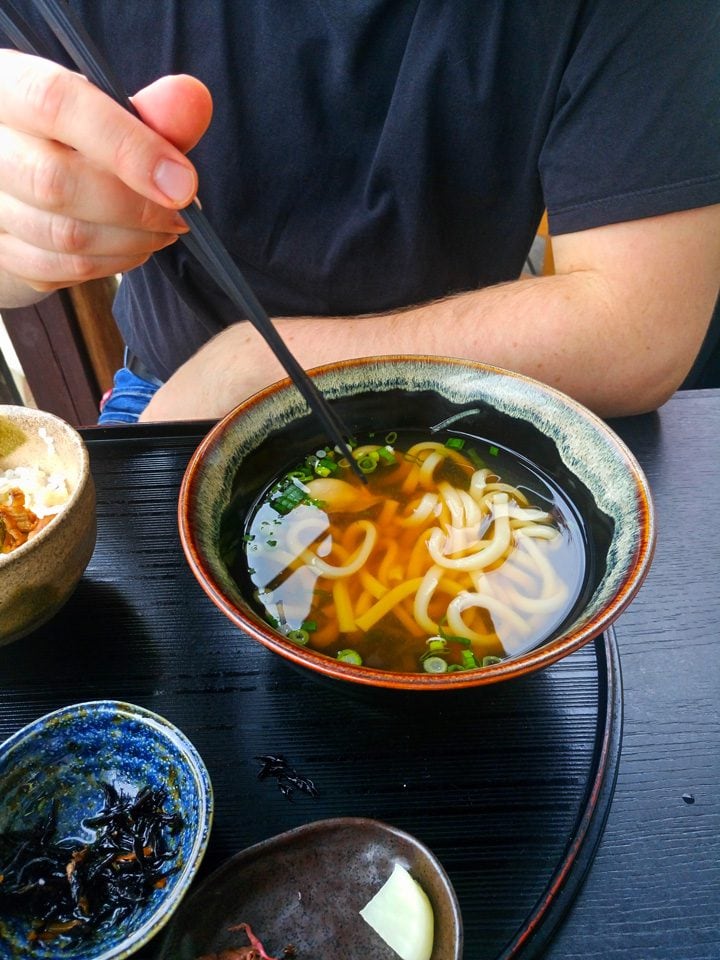
#1 Slurping is ok, but loud chewing is not when eating in Japan
Slurping your noodles is considered a sign that you’re enjoying your food very much. As an added bonus, it cools down the noodles!
On the other hand, blowing your nose at the table, audible chewing, and burping is definitely taboo. If you need to blow your nose, just excuse yourself to the bathroom.
#2 Finish your food
One of the fundamental concepts in Japanese culture is mottainai, which is a feeling of regret when you waste something.
You shouldn’t order more food than you can finish, as it’s definitely a breaking of Japanese dining etiquette. An even bigger taboo is ordering something more, like a dessert, when you haven’t finished the food that you have already.
So make sure to not order too many main meals, so you can try out that incredible matcha ice cream at the end without offending anyone!
#3 Put your dishes back to how they were when you received the food
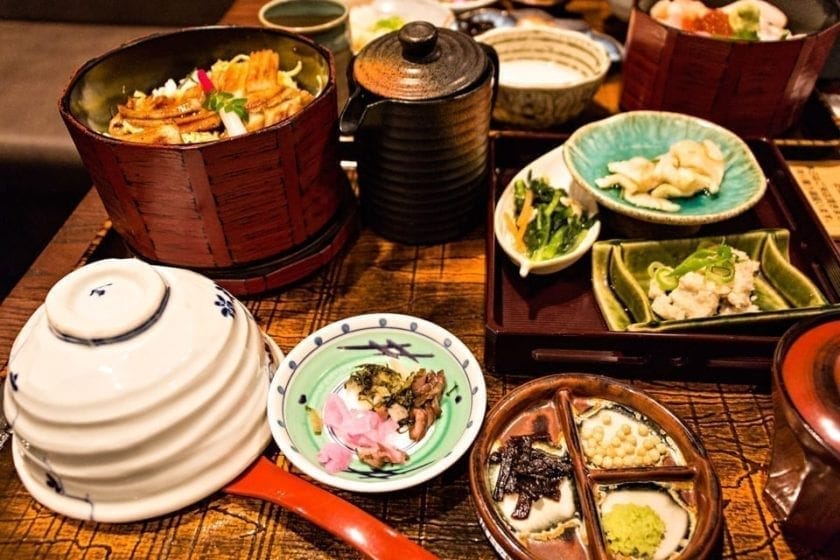
It’s common courtesy in many cultures and might not be liked in some others, but it’s expected that you put your dishes back to the way you received them after eating in Japan.
Put the plates on the tray, if you have it, replace the lids on the bowls, and put the chopsticks on the chopstick rest or back in the paper wrapper.
#4 Carry cash – it might not be possible to pay with a card
Japan is still largely a cash society.
Although paying with cards (or IC cards like Suica) is becoming more and more popular in Japan, still, many of the more traditional places accept only cash. So make sure you have enough!
After you finish your meal, the waiter will bring you a check and put it face down. Most probably you’ll have to bring your bill and pay at the cash by the entrance.
#5 No tipping in Japan!
Excellent service in Japan is standard and expected, hence tipping is not. It might even be considered rude and taboo, as it implies that the restaurant is not doing well enough to pay a decent wage to its workers.
If you leave a tip, don’t be surprised if the worker runs after you to return it.
#6 Don’t forget saying thank you in Japanese
After you finish your meal, it’s common courtesy to thank the hosts for the food.
Instead of saying a plain thank you, after eating in Japan, gochisosama or the more formal gochisōsama deshita is used.
Literally translated, it means It was a great deal of work, but, similarly to itadakimasu, it has a deeper meaning. By using gochisosama, you are being grateful to everyone who was involved with your food.
Since most probably you will have to pay for your meal at a cash register near the entrance, you should say the gochisōsama deshita there.
Failing to say thank you for the food in Japan is a big no-no.
#7 There are things you should know about eating sushi
If you haven’t caught on yet, know that there is sushi eating etiquette, too. Things like – don’t stick your chopsticks in sushi, or that you are allowed to eat it with your hands! Altogether, I think there are 9 most important rules, which I’ve listed in a sushi-rules article. Go check it out!
Summary about Japanese food culture
While it may seem that eating in Japan comes with too many rules and dining etiquette, it’s not actually anything too crazy.
Of course, some of the things like slurping noodles and drinking soup straight from the bowl seem unusual to the Westerner’s ear, but it all comes with the incredible experience that is Japan.
Do you know of any other interesting customs and rules about eating in Japan? What do you think about Japanese Food Culture? Share your idea into the comment section!
We believe this guide will help you to understand more about Japanese food culture.
Like this post? Pin it!
